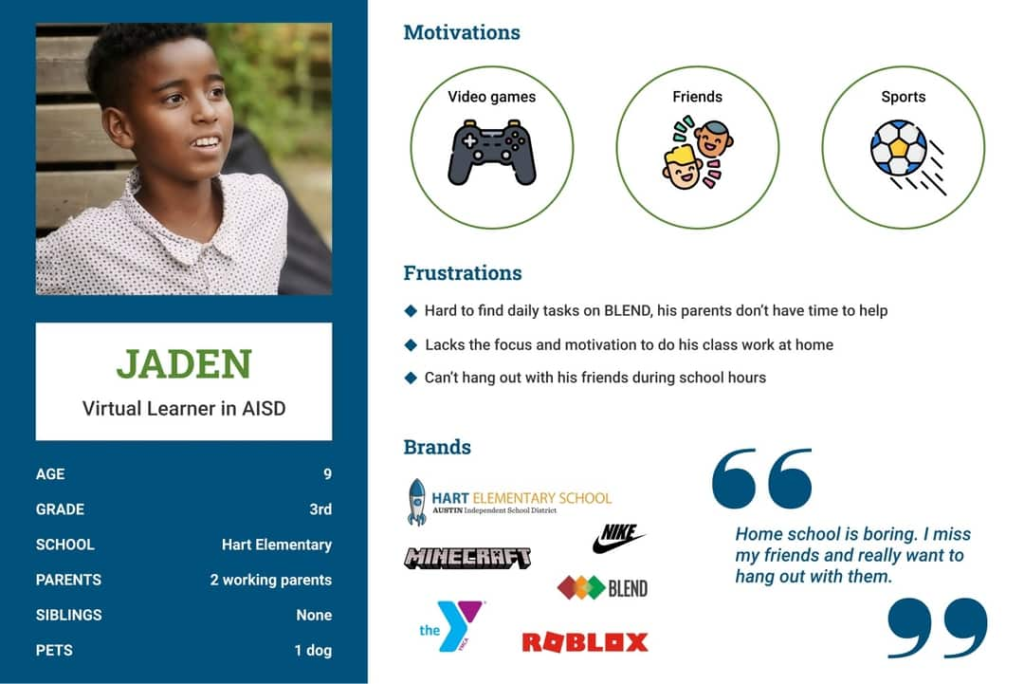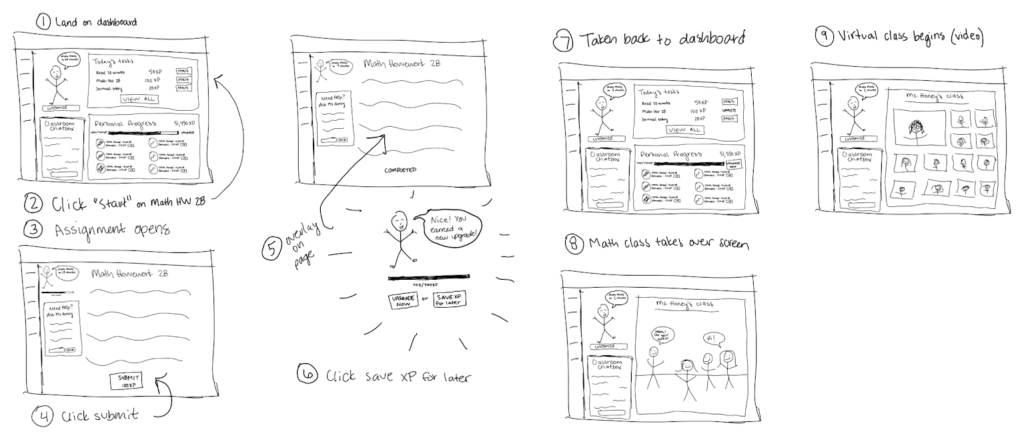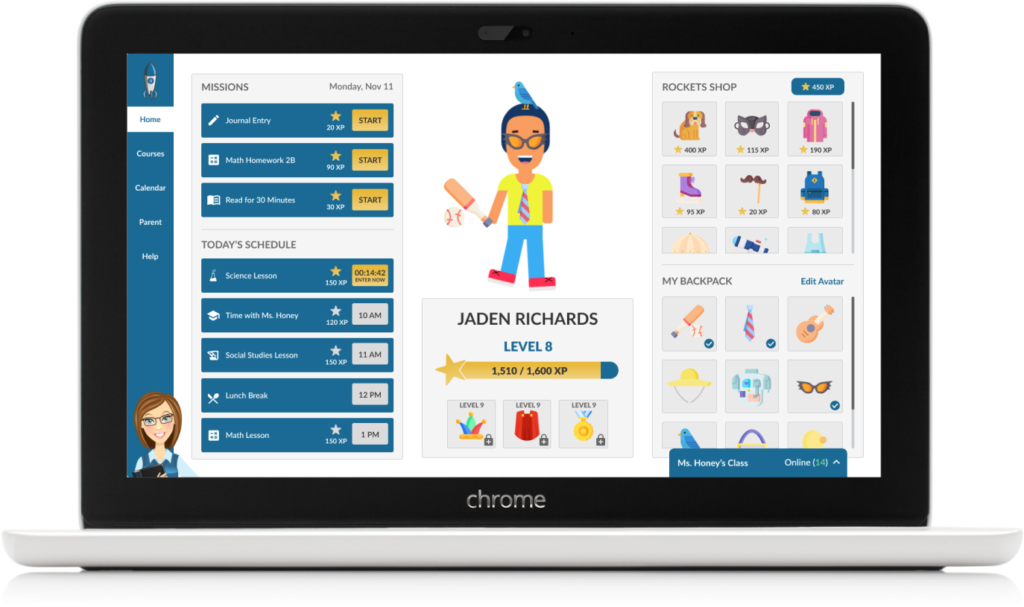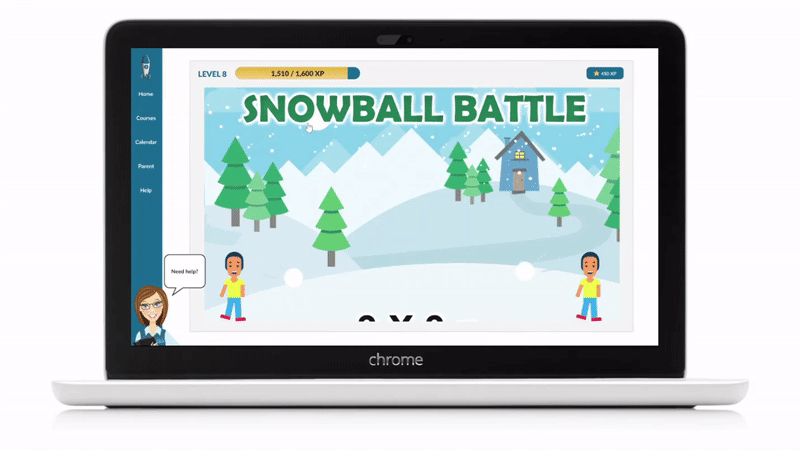Justin X. Hale
Award-Winning UX Designer
ROCKET – Design SPRINT
Case study read time = # minutes
Overview
Project Scope: 1 Week
Project Type: Pitch, Design Sprint
Roles: Content Strategy, Presenter, UI Designer, Game Creator, Gamify Researcher
Tools: Miro, Zoom, Figma, Photoshop
UX Techniques: Rapid Ideation, HMW Statements, Affinity Mapping, Sketching, Wireframes, Prototyping
Final Pitch: https://youtu.be/IXZ4s0m4BkU?t=1052
Those Involved: Cimone Almestica, Cameron Primm, Tina Avent, Amy Fraizer This was a virtual collaboration between myself and 4 team members – Team RIVERBATS!
Winning Pitch | Prototype
Background on Austin Design Week, Design-a-Thon
Austin Design Week’s Design-a-Thon presents a major problem facing Austin, and teams work to find design-based solutions. The 2021 prompt was to leverage design for common ground in a virtual society.
The 2021 design prompt was: Leverage design to find common ground in a virtual society.
Our solution had to answer the following touchpoints:
- How does the project affect our community?
- How will it make an impact?
- Can it scale?
- Is it feasible?
- Is it equitable and accessible to all?
Problem(s)
As of Oct 21, 2020, AISD’s failure rate increased by 70%, which was attributed to the pivot to remote learning necessary to combat COVID-19. The solution led to stress & loss in the common ground between students, parents, and teachers. Austin ISD’s remote learning platform BLEND, which was originally designed as an interface for college students, was known difficult to navigate since it wasn’t very intuitive (things not where thought they’d be), destinations were buried in layers of clicks, and how to add content wasn’t the clearest. This created low engagement for students and teachers. Aside from low engagement, we learned that young students also have difficulty navigating BLEND’s buried content. The dashboard is divided into subjects followed by yet another landing page. This has made it tricky for kids to locate assignments. Another problem was needing to use external tools. Not everything needed to teach is in BLEND.
- As of Oct 21, 2020, AISD’s failure rate increased by 70% due to the pivot to remote learning during COVID-19.
- Austin ISD’s remote learning platform BLEND was designed for college students, making it difficult to navigate for K-5 students, leading to low engagement.
Solution
ROCKET: A gamified dashboard for BLEND to increase student engagement. FINAL PITCH VIDEO (youtube)
My Role
My main roles included:
- Content Strategy, which allowed me to utilitize my skill of storytelling
- Game Creation, pushing my abilities in photoshop
- Parent UI Dashboard, allowed me to utilize figma by designing a high fidelity mockup for a desktop application.
Design-a-thon Timeline

We had one hour to research and define a problem, then three minutes to pitch a potential solution to judges. We were among the top five teams to move on to the next phase.

I conducted research and synthesized with my team, generated ideas, and led the design of our final UI prototype. I collaborated on writing our final pitch and created the presentation deck.

We had ten minutes to present our solution to the panel of design judges. ROCKET was announced as the first-place winner of Design-a-thon 2020.
Research
Create Personas
As part of our AISD research, two team members interviewed twelve students, teachers, and parents, yielding insights into the challenges of remote learning. From this collective effort, I took the lead in crafting the persona Jaden, a third-grader struggling with engagement during the pandemic. Jaden’s difficulties, from missing social interactions with friends to navigating BLEND without parental guidance, encapsulate the broader issues faced by students in the virtual learning landscape. This persona serves as a poignant illustration of the diverse struggles that emerge during these unprecedented times, emphasizing the need for tailored solutions to support individual students.

Competitive Analysis: Unveiling User Experience Insights
Diverse Organizational Methods: It became evident that each teacher adopts distinct approaches to organizing course material within BLEND. This diversity introduces a potential hurdle for students like Jaden, emphasizing the need for a more unified and intuitive structure.
Complex Navigation: Assignments and tasks were found to be concealed beneath layers of tabs and clicks, contributing to a cumbersome navigation experience. Recognizing this challenge, my initial strategy for the Competitive Analysis is centered on elevating actionable tasks to the forefront, aiming to establish a cohesive and user-friendly environment across all classes. This approach aligns to create a consistent and streamlined student experience within the BLEND platform.

But what about the KIDS?!
Venturing into the realm of video games, I delved into an exploration of some of the most beloved titles for children, ultimately focusing on Fortnite and Roblox. While these games may differ significantly, they share key functionalities that contribute to their sustained popularity, including:
Personal Customizable Avatar: Both Fortnite and Roblox offer players the opportunity to create and personalize their own avatars, fostering a sense of individuality and self-expression.
Interactive Social Features: A common thread between these games is the ability for players to engage in chat conversations with friends, establishing a social connection within the gaming environment.
Engaging Activities: Both platforms incorporate mini-games or missions that players can participate in to earn rewards. This dynamic element adds an interactive and rewarding dimension to the gaming experience, encouraging continued engagement.
Drawing inspiration from these gaming dynamics, the goal is to infuse similar elements into our solution, ROCKET, to enhance the virtual learning experience for young students within the AISD community.


Miro Collaboration: Crafting Solutions through Insightful Queries (Affinity Mapping)

In a collaborative effort on Miro, our team engaged in the process of gathering insights from our research findings. Employing this dynamic digital platform, we collectively delved into the complexities unearthed during our interviews and analysis. Driven by a desire to challenge and refine our approach to the identified problem, we initiated a series of thought-provoking “How might we…?” questions. This strategic inquiry aimed to stimulate innovative thinking and open avenues for creative problem-solving. The collaborative session on Miro served as a pivotal juncture, fostering a shared understanding of the challenges at hand and setting the stage for the ideation and solution development phases of our project.
Outcomes from mapping
Allow interaction
Allow safe interaction between students and classmates
Be accessible
Create a platform that is accessible to as many students as possible
Document progress
Document student progress to create common ground between parents and teachers
Ideation
Ideation: Unleashing Creativity through Rapid Sketching

Inspired by the gaming themes uncovered in our research, our team made a strategic decision to infuse elements like customizable avatars and reward systems into our ideation process. This approach aimed to enhance the engagement and user experience for students within the AISD community.
To propel our creative exploration further, we engaged in multiple rounds of rapid sketching, each followed by a collaborative critique session. This iterative process allowed us to refine and evolve our concepts organically. My initial sketches specifically honed in on the student task flow, visualizing the journey of completing math homework, earning upgrade rewards, and seamlessly transitioning to virtual class. This dynamic ideation phase became the catalyst for shaping the distinctive features and functionalities of our solution, ROCKET.
The Solution – ROCKET

Never Miss an Assignment, Earn Rewards for Task Completion
We reimagined the assignment experience by extracting it from hidden tabs and introducing a dedicated “Missions” section on the dashboard. This new design ensures that actionable tasks are prominently featured, fostering seamless communication between students and teachers.
In this innovative setup, every task carries XP points, adding a gamified layer to the learning journey. These earned XP points serve as currency to unlock various accessories for the student’s avatar, injecting an element of excitement and motivation into the process of completing school assignments. The integration of gamification not only streamlines task management but also transforms the academic landscape into an engaging and rewarding adventure for students.

Utilize XP Rewards to Enhance Your Avatar with Virtual Shop Items
Each student is equipped with a personalized avatar, open to customization through a variety of item upgrades. The Virtual Shop offers a range of avatar accessories that can be acquired using XP, adding an interactive layer to the learning experience.
As students progress, special items become attainable. Leveling up, achieved by accumulating a predetermined amount of XP for each level, unlocks these unique rewards. The student’s journey and progress can be easily tracked through the intuitive progress star bar, creating a visually appealing and motivating framework for their academic achievements.

Boosting Student Motivation with Gamified Assignments
Integrating gamified assignments transforms the learning experience, making it both engaging and less daunting for young students. The introduction of a reward system fosters a sense of healthy competition without pitting students against their peers; instead, rewards are earned based on individual progress. This approach not only enhances motivation but also cultivates a positive and personalized learning environment.

Establishing a Connection with the Parent Portal
Introducing the password-protected Parent Portal was my initiative to provide parents with a comprehensive tool for staying informed about their child’s academic journey. This secure portal enables parents to track upcoming and overdue assignments while accessing valuable teacher feedback.
Moreover, the Parent Portal fosters community engagement by offering caregivers a platform for communication through the parent chat box. Recognizing the significance of keeping parents actively involved, I advocated for this feature to address challenges related to parental engagement. This addition serves as a pivotal element in creating a stronger bridge between parents, their children’s education, and the collaborative school community.

Reflection
The Austin Design Week Design-a-Thon presented a high-pressure challenge, demanding innovative solutions within a one-week timeframe. Handling multiple roles, including Content Strategy, UI Design, and Game Creation, the successful introduction of ROCKET, a gamified dashboard, during the final pitch and prototype underscored my ability to navigate tight deadlines and embrace creative solutions. Despite initial skepticism, particularly regarding the game element, I remained steadfast in my belief that a game could effectively showcase our software, ROCKET. This experience turned skepticism into a valuable learning point, highlighting the importance of resilience and creative problem-solving in the face of pushback. Additionally, the foresight to introduce the Parent Portal demonstrated a commitment to holistic problem-solving, addressing issues of parental engagement and contributing to a more cohesive educational environment. This multifaceted experience not only affirmed technical skills but also emphasized collaborative leadership and innovation in time-sensitive scenarios, showcasing the power of persistence and creative thinking within a team context.
